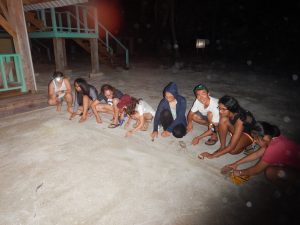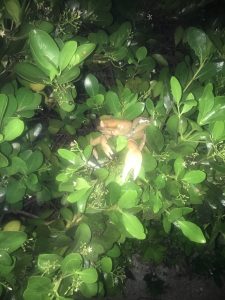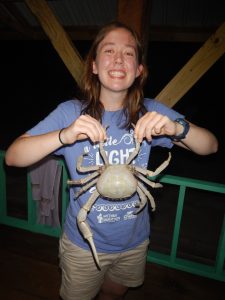Day 3 of Beach Days
Today’s activity definitely took a toll on us — but our Dermit Rab made it all better.

We woke up, ate, and swam to the edge of the thousand-feet-drop in the benthos (sea floor). On the way, the supposedly calm waters rocked us to differing degrees of sea sickness. In the water we went in all different directions with regards to the waves, on which we bobbed up and down while we looked in the deeper ocean for interesting life forms. One of the forereefs we explored was geographically filled with canyons of corals. Centuries of wave engergy shaped the current-day grooves filled with hard and soft corals, among other life forms. We observed an especially problematic species of fish, called the lion fish, camouflouging in the corals today. Their presence in this region, which is far from their native rainge, has caused up to 70% decline in native fish populations. Obviously, we speared them and brought them back to dissect, fry, and eat. Which is a prospect even the “vegetarians” are supporting.
In the afternoon, we quanitified the degree of biodiversity of Echinoderms (particularly sea urchins) in a protected and an unprotected marine area. Which means we spent an hour spotting and picking off the spiny sea urchins from dead corals and algae on which they are grazing. While searching for sea urchins, I saw two types of brown algae, specifically, they were two types of white-scrolled algae. One has a darker base and the other a lighter color, but both have a characteristic curly shape that resembles a scroll. In addition, we came into contact with Sargassm seadweed again, which is more or less impossible not to come into contact with due to their prevalence and distribution on the ocean surface. In addition we observed many blister saucer algae, both attached to corals and floating on the surface. Interesting, they too, like the Sargassum, are able to keep some air within their chambered body so that when squished air bubbles are released. Although they do not have a characteristic air bladder like the sea weed, these saucer algae had triangular bulbous organs to hold air.
In the evening, we had one of the best meals we’ve had yet — consisting of flan, spiced chicken, banana bread, lemon cookies, homemade bread, and mashed potato. After our lectures, we collected blue crabs and hermit crabs to race in the sand. Among 5+ competitors, one travelled in the opposite direction, 1 paused, and 2 finished close to each other. It seems like the large hermit crabs are the best for Dermit Rab. Also obvious that blue land crabs are not the best as they walk side ways and are prone to going to dark places to hide. Angus, me and Claire’s contestant, although big, did just that. :/
The communal nap I have been predicting and advocating for — also happened today! Our tiredness has come to an all time high, but with proper rest, i.e. communal naps, we seem to be a very resilient group.



